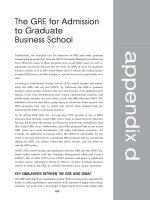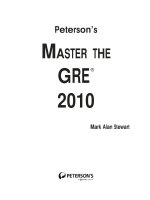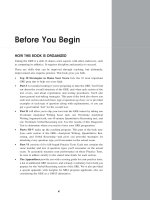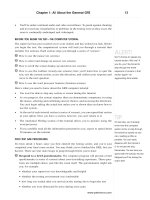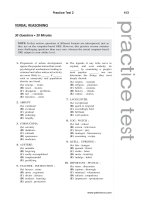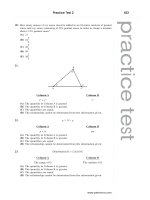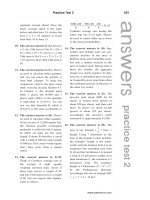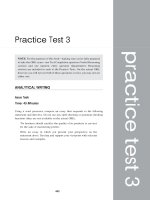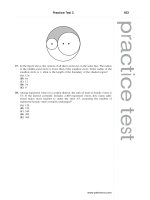Tài liệu Master the Gre 2010 - Part 14 ppt
Bạn đang xem bản rút gọn của tài liệu. Xem và tải ngay bản đầy đủ của tài liệu tại đây (72.25 KB, 10 trang )
The Argument Task
OVERVIEW
• Key facts about the GRE Argument task
• The 7-step plan
• GRE Argument flaws—and how to handle them
• Argument task strategies
• Summing it up
In this chapter, you’ll find out how to write an effective GRE Argument essay.
First, you’ll learn a step-by-step approach to brainstorming, organizing, com-
posing, and fine-tuning your Argument essay, all within the exam’s 30-minute
time limit. By following this step-by-step plan, you’ll increase your chances of
attaining a better-than-average Argument task score of at least 4 on the 0–6
scale.
Then, later in the chapter, you’ll focus on the most common types of reasoning
flaws in GRE Arguments. You’ll learn how to recognize and handle each type,
since this is the skill that separates the best Argument essays—those earning
a score of 5 or 6—from all the others.
At the end of the chapter, you’ll review the keys to writing a high-scoring GRE
Argument essay.
KEY FACTS ABOUT THE GRE ARGUMENT TASK
You first looked at the Argument writing task in Chapter 2 and in this book’s
Diagnostic Test. Here’s a quick review of key facts about this component of GRE
Analytical Writing.
Where: Either immediately before or after the Issue writing task (the two
Analytical Writing tasks come at the beginning of the exam, before all Quan-
titative and Verbal Reasoning sections)
How Many: One essay
Time Allowed: 30 minutes
General Directive: You write an essay in which you discuss how well-
reasoned you find a particular Argument—specifically, the following four
aspects (1 and 2 are primary tasks):
chapter5
....................................................................................
113
The Argument’s unsubstantiated or unreasonable assumptions
Problems with the Argument’s internal logic or line of reasoning
How the Argument can be strengthened (optional)
What additional information is needed to better evaluate the Argument (optional)
Abilities Tested:
• Your ability to recognize unstated assumptions and other reasoning flaws in
arguments
• Your ability to communicate your critique of an argument cogently and effectively,
using relevant reasons and/or counterexamples
• Your ability to present your ideas in a cohesive, well-organized manner
• Your ability to communicate your ideas adequately, using the conventions of
Standard Written English (but language, syntax, grammar, and writing
mechanics are not nearly as important as content and organization)
Other Key Facts:
• The Argument is presented in the form of a brief, paragraph-length quoted
statement from a fictitious source.
• Regardless of the specific Argument that the test presents, the directive (your
task) is always the same: Discuss how well-reasoned you find the argument.
• There is no prescribed or “correct” word length for an Argument essay.
• Scratch paper and pencils are provided (just as in the other exam sections).
• The system’s basic word processor has a simple cut-and-paste function but no
spell-checking or grammar-checking functions.
THE 7-STEP PLAN
For a high-scoring Argument essay, you need to accomplish the following basic
objectives:
• Identify and analyze the Argument’s key elements.
• Organize, develop, and express your critique in a coherent and logically con-
vincing manner.
• Support your ideas with sound reasons and examples.
• Demonstrate adequate control of the elements of Standard Written English
(grammar, syntax, and usage).
Thirty minutes isn’t much time to accomplish these tasks, so you need to use that time
wisely. This does not mean using every one of your 30 minutes to peck madly at the
keyboard, however. You should spend some time first thinking about what you want to
write and how to organize your ideas. You should also allocate at least the final few of
your 30 minutes to proofread and fine-tune your essay.
PART III: Analytical Writing114
.................................................................
..............................................................................................
TIP
The Argument task prompt will
direct you to discuss “how
well-reasoned” you find the
Argument; but in reality, your
job will be to discuss how
poorly reasoned it is—as you’ll
learn in this chapter.
www.petersons.com
Here’s the 7-step plan (with suggested time for each step) to help you budget your
time so you can accomplish all four objectives listed above within 30 minutes:
Read the Argument and identify its conclusion(s) (1 minute).
Examine the Argument’s evidence and determine how strongly it supports the
conclusion(s) (3 minutes).
Organize and prioritize your points of critique (1 minute).
Compose a brief introductory paragraph (2 minutes).
Compose the body of your essay (16 minutes).
Compose a final paragraph (2 minutes).
Proofread for mechanical problems (5 minutes).
By following the suggested times for each step, you’ll spend about 5 minutes planning
your essay, 20 minutes writing, and 5 minutes proofreading it.
In the following pages, we’ll apply each of these steps to the following GRE-style
Argument prompt (remember, the directive is the same regardless of the Argument):
Argument 1 (followed by the directive)
The following appeared in a memo from the manager of UpperCuts hair salon:
“According to a nationwide demographic study, more and more people today are
moving from suburbs to downtown areas. In order to boost sagging profits at
UpperCuts, we should take advantage of this trend by relocating the salon from
its current location in Apton’s suburban mall to downtown Apton, while
retaining the salon’s decidedly upscale ambiance. Besides, Hair-Dooz, our chief
competitor at the mall, has just relocated downtown and is thriving at its new
location, and the most prosperous hair salon in nearby Brainard is located in
that city’s downtown area. By emulating the locations of these two successful
salons, UpperCuts is certain to attract more customers.”
Discuss how well-reasoned you find this argument.
Step 1: Read the Argument and Identify Its Conclusion(s) (1 minute)
Every GRE Argument consists of the following three basic elements:
Evidence (stated premises that the Argument does not dispute)
Assumptions (unstated premises needed to justify a conclusion)
Conclusions (inferences drawn from evidence and assumptions)
As you read an Argument for the first time, identify its final conclusion as well as its
intermediate conclusion (if any). Why is this first step so important? Unless you are
clear about the Argument’s conclusions, you cannot evaluate the author’s reasoning or
the strength of the evidence offered in support of them. And that’s what the Argument
writing task is all about!
You’ll probably find the final conclusion in the Argument’s first or last sentence. The
Argument might refer to it as a “claim,” a “recommendation,” or a “prediction.” An
Chapter 5: The Argument Task 115
.................................................................
..............................................................................................
www.petersons.com
intermediate conclusion, upon which the final conclusion depends, might appear
anywhere in the Argument. Not every Argument contains an intermediate conclusion.
Did you identify and distinguish between the intermediate and final conclusions in
the Argument 1? Here they are:
Intermediate conclusion
“By emulating the locations of these two successful salons, UpperCuts is
certain to attract more customers.”
Final conclusion
“In order to boost sagging profits at UpperCuts, we should...relocate the
salon from its current location in Apton’s suburban mall to downtown Apton,
while retaining the salon’s decidedly upscale ambiance.”
Notice that the Argument’s final conclusion relies on its intermediate conclusions.
Here’s the essential line of reasoning:
UC will gain customers if it moves downtown. (Intermediate conclusion)
Therefore, UC will boost its profits simply by moving downtown. (Final
conclusion)
Always jot down an Argument’s intermediate conclusion (if any) and its final con-
clusion (shorthand form will do). You’ll need to refer to them time and again as you
develop your points of critique and compose your essay.
Step 2: Examine the Argument’s Evidence and Determine How
Strongly It Supports the Conclusion(s) (3 minutes)
Most GRE Arguments contain at least two or three items of information (or evidence)
supporting their conclusion(s). Identify these items, label them, and jot them down on
your scratch paper. Argument Statement 1 contains three distinct items of evidence:
Evidence Item 1
“According to a nationwide demographic study, more and more people today
are moving from suburbs to downtown areas.”
Evidence Item 2
“Hair-Dooz, our chief competitor at the mall, has just relocated downtown
and is thriving at its new location.”
Evidence Item 3
“[T]he most prosperous hair salon in nearby Brainard is located in that
city’s downtown area.”
Next, analyze each item to determine how much support it lends to the Argument’s
intermediate and final conclusions. The test directions that you’ll view just before
your Argument prompt will instruct you to look for unsubstantiated or unreasonable
assumptions on which the Argument’s conclusions depend. For example, an Argument
PART III: Analytical Writing116
.................................................................
..............................................................................................
www.petersons.com
might rely on one of the following assumptions but fail to provide evidence to support
the assumption:
• An event that occurs after another one has been caused by the other (a false-
cause problem).
• Two things that are similar in one way are similar in other ways (a false-analogy
problem).
• A statistical sample of a group is representative of the group as a whole.
The test’s directions will also instruct you to check for problems with the Argument’s
internal logic—for example, the Argument is self-contradictory or employs circular
reasoning. Just as with your Issue essay, don’t filter your ideas during the crucial
brainstorming step. Just put them all down on paper for the time being; you’ll sort
them out in step 3.
Here’s what a test taker’s notes for Argument 1 might look like after a few minutes of
brainstorming:
inter. concl.—UC will gain customers downtown
final concl.—UC will improve profits downtown
• demog. study—is Apton typical? no trend
reverse trend
• success of HD—is location key? marketing
key stylist
• success of B salon—downtown location key?
—is Apton like Brainard? (demog.)
• other problems
—relocation expenses offset revenues
—UC must establish new clientele
—competition from HD
(suff. demand for both salons?)
—demand for “upscale” salon downtown?
Step 3: Organize and Prioritize Your Points of Critique (1 minute)
Using your notes from step 2 as a guide, arrange your ideas into paragraphs (probably
three or four, depending on the number of problems built into the Argument). Take a
minute to consider whether any of the flaws you identified overlap, and whether you can
separate any of them into two distinct problems. In many cases, the best way to organize
your points of critique is to put them in the same order in which the reasoning problems
arise in the Argument itself.
Chapter 5: The Argument Task 117
.................................................................
..............................................................................................
TIP
Without exception, each
Argument in the official GRE
exam pool contains at least
three or four distinct
assumptions or other
problems—that’s how the test
makers design them. Make
sure you review the section of
this chapter where we
examine in detail the most
common GRE Argument flaws.
www.petersons.com
